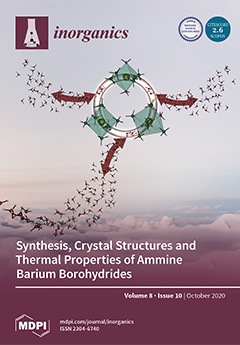Ammine metal borohydrides show large compositional and structural diversity, and have been proposed as candidates for solid-state ammonia and hydrogen storage as well as fast cationic conductors. Here, we report the synthesis method of ammine barium borohydrides, Ba(BH
4)
2·
xNH
3 (
x = 1, 2). The two new compounds were investigated with time-resolved temperature-varied in situ synchrotron radiation powder X-ray diffraction, thermal analysis, infrared spectroscopy and photographic analysis. The compound Ba(BH
4)
2·2NH
3 crystallizes in an orthorhombic unit cell with space group symmetry
Pnc2, and is isostructural to Sr(BH
4)
2·2NH
3, forming octahedral [Ba(NH
3)
2(BH
4)
4] complexes, which are connected into a two-dimensional layered structure, where the layers are interconnected by dihydrogen bonds, N–H
δ+⋯
−δH–B. A new structure type is observed for Ba(BH
4)
2·NH
3, which crystallizes in an orthorhombic unit cell with space group symmetry
P2
12
12
1, forming a three-dimensional framework structure of [Ba(NH
3)(BH
4)
6] complexes. The structure is built from distorted hexagonal chains, where NH
3 groups form dihydrogen bonds to the nearby BH
4−-groups within the chain. Ba(BH
4)
2·2NH
3 is unstable at room temperature and releases NH
3 in two subsequent endothermic reactions with maxima at 49 and 117 °C, eventually reforming Ba(BH
4)
2. We demonstrate that the thermal stability and composition of the gas release for the ammine alkaline earth metal borohydrides can be correlated to the charge density of the metal cation, but are also influenced by other effects.
Full article





